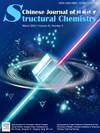CuMoRuFeW high entropy alloy surfaced nanorods: Superior electrochemical CO2 reduction to ethylene
IF 5.9
4区 化学
Q1 CHEMISTRY, INORGANIC & NUCLEAR
引用次数: 0
Abstract
Electrocatalytic carbon dioxide reduction (CO2ER) driven by renewable energy sources to produce high-value-added chemicals is a highly promising strategy for achieving a closed carbon cycle. Cu is the only highly active catalyst capable of producing multi-carbon (C2+) products through CO2ER. However, due to the constraints of existing scaling relationships and competing hydrogen evolution reaction, it is still challenging to achieve high selectivity of a single desired product. In this work, high-entropy alloy (HEA) CuMoRuFeW surface skin on Cu nanorods was obtained by a one-pot co-reduction method. It is revealed that Fe could effectively facilitate the co-reduction of Mo and W precursors and the formation of HEA surface on Cu nanorod. The Faradaic efficiency (FE) for ethylene and ethanol in CO2ER reaches 49.5% and 20.4%, respectively, with a total FEC2 of 69.9% and current density of 250 mA cm−2 at −1.1 V vs. RHE. Theoretical calculations reveal that the Cu–W–Fe combination site is more active in CO2 activation and C–C coupling for C2 products than other sites. This work underscores the importance of HEA in overcoming the constraints of linear scaling relationships and improving the selectivity for C2 products in CO2ER.
CuMoRuFeW高熵合金表面纳米棒:卓越的电化学CO2还原为乙烯
由可再生能源驱动的电催化二氧化碳还原(CO2ER)生产高附加值化学品是一种非常有前途的实现封闭碳循环的策略。Cu是唯一能够通过CO2ER生成多碳(C2+)产物的高活性催化剂。然而,由于现有的标度关系和相互竞争的析氢反应的限制,实现单一期望产物的高选择性仍然具有挑战性。本文采用一锅共还原法制备了Cu纳米棒上的高熵合金(HEA) CuMoRuFeW表面表皮。结果表明,Fe能有效促进Mo和W前驱体的共还原,并在Cu纳米棒上形成HEA表面。与RHE相比,CO2ER中乙烯和乙醇的法拉第效率(FE)分别达到49.5%和20.4%,总FEC2为69.9%,电流密度为250 mA cm−2(−1.1 V)。理论计算表明,Cu-W-Fe结合位点在C2产物的CO2活化和C-C偶联中比其他位点更活跃。这项工作强调了HEA在克服线性缩放关系的限制和提高CO2ER中C2产物的选择性方面的重要性。
本文章由计算机程序翻译,如有差异,请以英文原文为准。
求助全文
约1分钟内获得全文
求助全文
来源期刊

结构化学
化学-晶体学
CiteScore
4.70
自引率
22.70%
发文量
5334
审稿时长
13 days
期刊介绍:
Chinese Journal of Structural Chemistry “JIEGOU HUAXUE ”, an academic journal consisting of reviews, articles, communications and notes, provides a forum for the reporting and discussion of current novel research achievements in the fields of structural chemistry, crystallography, spectroscopy, quantum chemistry, pharmaceutical chemistry, biochemistry, material science, etc. Structural Chemistry has been indexed by SCI, CA, and some other prestigious publications.
 求助内容:
求助内容: 应助结果提醒方式:
应助结果提醒方式:


